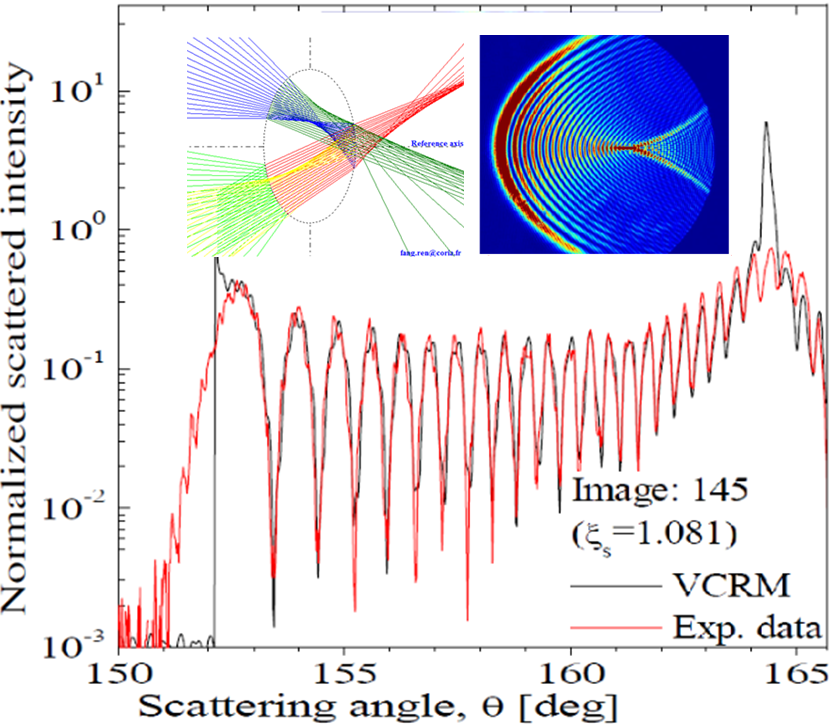Download
Tools available for the research in this site are freeware. For more functions of these tools the readers may address to the authors.
1. VCRMEll2D
 VCRMEll2D is the first realization of the Vectorial Complex Ray Model - VCRM developed by the author. By introducing the property of the Wavefront in the geometrical optics model, the VCRM can calculate very precisely the interaction of a wave of any form with a object of smooth surface and size much larger than the wavelength of the incident beam.
VCRMEll2D is the first realization of the Vectorial Complex Ray Model - VCRM developed by the author. By introducing the property of the Wavefront in the geometrical optics model, the VCRM can calculate very precisely the interaction of a wave of any form with a object of smooth surface and size much larger than the wavelength of the incident beam.VCRMEll2D is designed to predict the scattering of a plane wave by an ellipsoid in the plane of symmetry. With this software, we can follow step by step the path of rays in a particle and to check the variation of the curvature radii of the wavefront by the divergence / convergence on the particle surface. It also allows to calculate the scattering diagrams in all directions.
The scattering diagram ccalculated by the VCRM is compared in this figure with a experimental result.
Download the software from here. The zip file containing executable and parameter files.
The original version of the software is licenced under n°IDDN.FR.001.130023.000.R.P.2014.000.30000
You can read the elated publications:
- K. F. Ren*, F. Onofri, C. Rozé and T. Girasole, "Vectorial complex ray model and application to two-dimensional scattering of plane wave by a spheroidal particle", Opt. Lett., 36(3):370-372, 2011
- K. F. Ren*, C. Rozé and T. Girasole, "Scattering and transversal divergence of an ellipsoidal particle by using Vectorial Complex Ray Model", J. Quant. Spectrosc. Radiat. Transfer, 113:2419–2423, 2012
- K. Jiang, X. Han, K. F. Ren*, "Scattering from an elliptical cylinder by using the vectorial complex ray model", Appl. Opt., 51(34):8159-8167, 2012
- K. Jiang, X. Han, K. F. Ren*, "Scattering of a Gaussian beam by an elliptical cylinder using the vectorial complex ray model", J. Opt. Soc. Am. A., 30(8):1548-1556, 2013
- M. Yang, Y. Wu, X. Sheng and K. F. Ren*, "Comparison of scattering diagrams of large non-spherical particles calculated by VCRM and MLFMA", J. Quant. Spectrosc. Radiat. Transfer, 10.1016/j.jqsrt. 2015.01.024, 2015
- K. F. Ren*, "Airy theory revisited and caustics in Vectorial Complex Ray Model", 7th World Congress on Particle Technology (WCPT7), in Beijing (China), May 19 to May 22, 2014
2. ABSPhere
 ABSphere is based on the rigorous theory to calculate various physical quantities in the interaction of a light beam with a homogeneous spherical particle or with a concentric layered refractive index gradient. The user-friendly interface facilitates the usagee of the software and the interpretation of results.
ABSphere is based on the rigorous theory to calculate various physical quantities in the interaction of a light beam with a homogeneous spherical particle or with a concentric layered refractive index gradient. The user-friendly interface facilitates the usagee of the software and the interpretation of results.ABSphere allows to calculate: (1) scattering diagrams, (2) radiation pressure (force) and torque exerted by a beam of light on the particle, (3). internal and external electromagnetic fields, (4). extinction, scattering and absorption sections. The forms of the beam considered in ABSphere: (1) circular Gaussian beam. (2) elliptical Gaussian beam. (3) Dungnut beam of 4 different polarizations, (4). Bessel beam (5). Any form of a beam defined by the beam shape provided by the user with a file.
The original version of the software is licenced under n°IDDN.FR.001.130022.000.R.P.2014.000.30000
You can read the elated publications:
- K. F. Ren, G. Grehan and G. Gouesbet, "Localized approximation of generalized Lorenz-Mie theory : faster algorithm for computations of beam shape coefficients gmn, Part. Part. Syst.Charact., 9, 144-150, 1992
- K. F. Ren, G. Grehan and G. Gouesbet, "Radiation pressure forces exerted on a particle arbitrarily located in a Gaussian beam by using the generalized Lorenz-Mie theory, and associated resonance effects, Opt. Commun., 108, 343-354, 1994
- K. F. Ren, “Diffusion des Faisceaux Feuille Laser par une Particule Sphérique et Applications aux Ecoulements Diphasiques”, thèse soutenue à l’Université de Rouen, le 31 mars 1995
- K. F. Ren, G. Grehan and G. Gouesbet, “Prediction of reverse radiation pressure by generalized Lorenz-Mie theory”, Appl. Opt., 35(15), pp. 2702-2710, 1996
- K. F. Ren, G. Gouesbet and G. Grehan, "The integral localized approximation in generalized Lorenz-Mie theory, Appl. Opt., 37(19), pp.4218-4225, 1998
- K. F. Ren* "Numerical techniques for shaped beam scattering by large and absorbing particle using variable separation methods" , 10th Intern. Conf. on Laser-light and Interactions with Particles (LIP 2014), Marseille (France), Aug. 25-29th, 2014 Keynote
- K. F. Ren, "ABSphere - Software for calculation of all physical properties of any shaped beam by spherical particle" , 10th Intern. Conf. on Laser-light and Interactions with Particles (LIP 2014), Aug. 25-29th, 2014, Marseille (France) 2014



